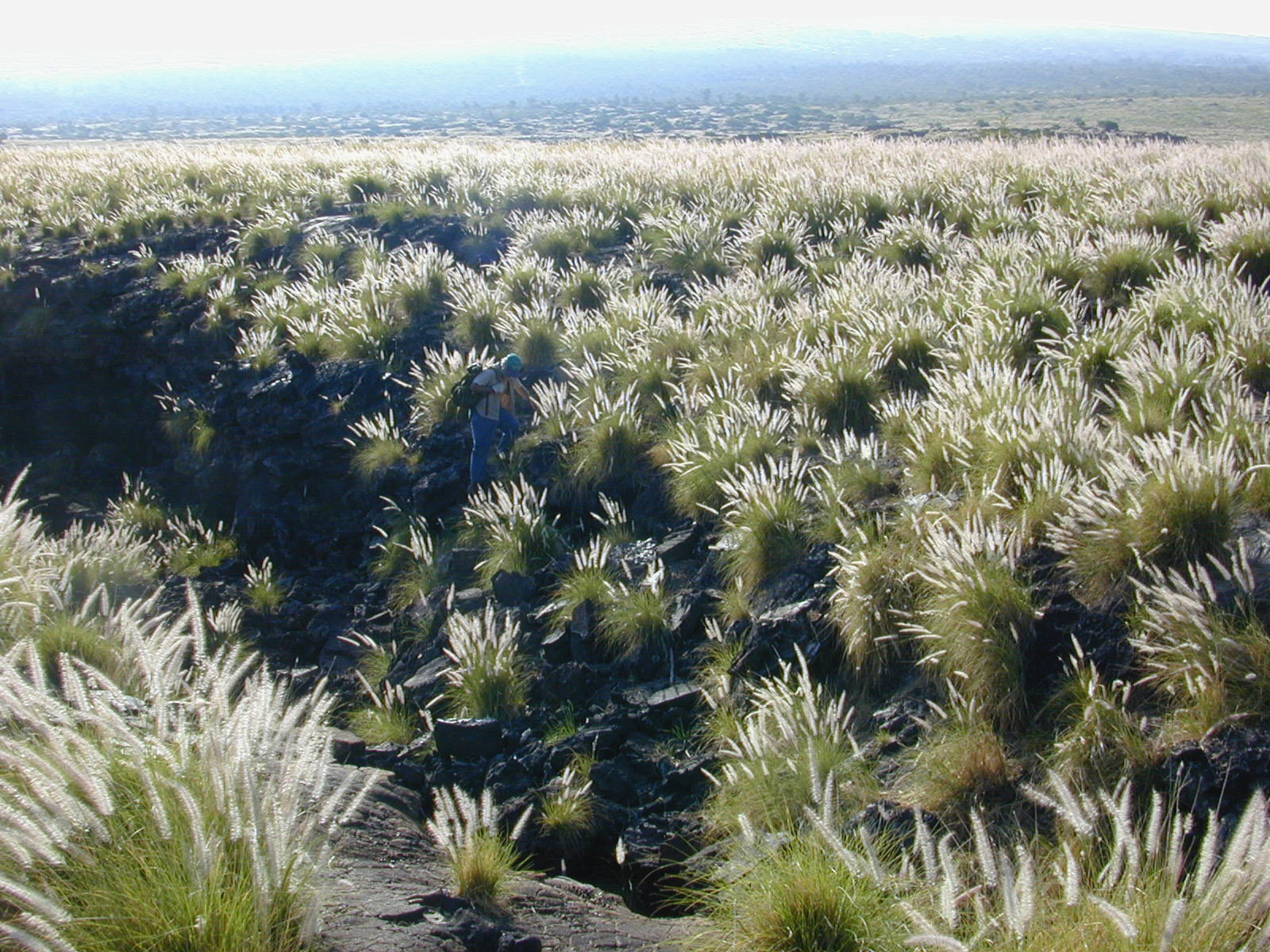|

A Key to the Grasses, Sedges, & Rushes
of the Hawaiian Islands
by
Eric B. Guinther, senior ecologist
AECOS Inc.

|
|


INTRODUCTION
|
|
True grasses are classified as plants in the Family Poaceae (Gramineae in older sources) and are among the most successful plants on the planet earth with 9,000 or more species described worldwide. Sedges, while they generally resemble grasses, are separately classified in the Family Cyperaceae, with some 5500 species worldwide. Rushes are mostly in the Family Juncaceae and superficially resemble sedges; in fact, a few rushes (like bulrush) are sedges. The Family Juncaceae is a small one with only about 464 known species in 8 genera. This CPIE "notebook" project is an attempt to provide a naturalist-friendly, hypertext, identification guide to all three of these plant families as they are represented in the Hawaiian Islands, where some 286 species of grasses, 70 species of sedges, and 8 species of rushes are found in nature, grown as crops, or used in landscaping [FN]. Recent papers by K. Faccenda (2022, 2023a) have increased the known introduced grasses in Hawai‘i by some 34 species. While many are uncommon or rare, the collections represent roadside and disturbed sites, suggesting revisions to the identification keys presented here are warranted (and underway as of January 2024).
Grasses and sedges can be found just about everywhere in Hawai‘i: some thrive in wetlands, others in the shade of the forest, but most prefer open (unshaded) ground, the grasses particularly dominating fields, lawns, and recently disturbed sites. Most places you find grasses, you will also find sedges, although typically in much lesser abundance. Rushes tend to be encountered much less often, except at somewhat cooler elevations as can be found on Maui and Hawai‘i Islands. The identification keys presented here differentiate 189 taxa of grasses, 66 taxa of sedges, and 8 species of true rushes. An advantage of a self-published key on the internet is that these numbers will increase as additional species decriptions are added. A complete listing of the included taxa is provided on the Index page and recently added is a list of species reported to be in Hawai‘i but not yet added to the keys; see SPECIES NOT INCLUDED.
Career-long experiences visiting numerous Pacific islands and particularly more recent trips to tropical areas (notably South America and Australia) have brought to my attention the fact that, in disturbed locations at least, the weedy flora can be much the same as that found in lowland Hawai‘i. The key to grasses produced here could have utility in many other parts of the Pacific, although aids built in to enhance confirmation of an identification would be lacking. Building on this premise, A Key to the Grasses, Sedges, & Rushes of the Hawaiian Islands has been expanded to incorporate the grasses, sedges, and rushes reported from the Island of Guam in the Marianas. A separate Guam Introduction facilitates this use.
|
|
Separating Grasses, Sedges, Rushes and other Monocots
Most grasses are easily recognizable as such, although members of several other plant families do resemble grasses, and in the absence of flowering structures, could be mistaken for grasses. Recall that flowering plants are divided into dicots (germinating seed produces two seed leaves or cotyledons) and monocots (germinating seeds produce a single seed leaf). Grasses, sedges, and rushes are monocots, and their basic structural characteristics are typical of the majority of monocotyledonous plants: leaves with parallel veins, fibrous roots, and other consistent floral and internal structures that differ from those of dicots (see Monocots and Dicots Chart).
Plants that are not grasses—but closely resemble grasses—are very likely other monocots. Sedges (Family Cyperaceae) are the most common grass-like plants encountered in nature. Sedges differ from grasses in a number of respects. Generally, sedges are coarser, the leaves concentrated around the base of a stem (or culm) or occuring as bracts (one or more stem or leaf-like appendages below the flowering heads), or so reduced in size as to appear absent. The culm may be triangular ("sedges have edges") in cross-section and solid, not hollow (although there are hollow culms in the family. Bulrush (Schoenoplectus spp.) is a sedge with a hollow (and mostly rounded) culm. Sedges are typically more abundant than grasses in wetlands and wet areas.
Rushes of the Family Juncaceae are rather uncommon in Hawai‘i, and likely to be mistaken for sedges if not flowering. Other rushes are included in the Family Cyperaceae. A few monocots are named, in common parlance, "grasses", but are not. Examples are: nut grass, a common lawn weed (it is a sedge), menehune grass (another sedge), and mondo grass (Ophiopogon spp., Family Liliaceae). A number of fully aquatic grass-like plants resemble (but are not) grasses, for examples: widgeon grass (Ruppia maritima, Family Ruppiaceae) and tapegrass (Vallisneria spiralis, Family Hydrocharitaceae). These aquatic plants can be keyed out at [CPIE] Vascular Plants where you can choose a plant family from a listing on that web page OR start at the first couplet [70].
The couplets following provide a beginner's version of our dichotomous key and are modified from Keys to the Aquatic Biota of the Hawaiian Islands to separate sedges and grasses found in wetlands and along streams and should serve adequately here. Presently, selecting a choice leading to plants other than sedges or grasses will go to the CPIE aquatic biota key. Use link at bottom left of page if you are not experienced using dichotomous keys. Another option for identifying Hawaiian grasses, sedges and rushes are the CPIE MultiAccess Keys, starting at Herbaceous Plants in Hawai'i. A multi-access key will be easier to use than a dichotomous key for those finding the latter somewhat intimidating, and our multi-access key to the grasses is fully integrated with the dichotomous key, providing links to pictures and descriptions.
|
|
|
|